
Europe and Mediterranean: Stars of Iberia
Regent Seven Seas Cruises
Situated on Spain's Costa del Sol, Malaga is the region's capital and a popular holiday destination. The city is also renowned as the birthplace of Pablo Picasso, whose works can be seen in the recently opened Museo Picasso, housed in the Palacio de Buenavista. This is a pleasant town to explore and also serves as a popular starting point for excursions to splendid Granada and the famed Alhambra, located inland at the foothills of the Sierra Nevada.

All onboard gratuities
Select complimentary shore excursions**
Unlimited beverages, including fine wines and premium spirits served throughout the ship
In-suite refrigerator replenished daily with soft drinks, beer and bottled water
24-Hour room service
No charge for specialty restaurants
Welcome bottle of Champagne
$100 Shipboard credit per suite††
Executive Member Benefit
Executive Members receive an annual 2% Reward, up to $1,250, on qualified Costco Travel purchases
Executive Members receive an additional $100 shipboard credit per suite (not combinable with certain past-guest discounts)††
Digital Costco Shop Card
Member Exclusive: Digital Costco Shop Card with every Regent Seven Seas Cruises® sailing†
Sailing Itinerary

Note: Cruise itineraries are subject to change. Please verify ports and times directly with the cruise line.
Overview
Lisbon is Portugal’s hilly, coastal capital city. From the imposing São Jorge Castle, the view encompasses the old city’s pastel-colored buildings, Tagus Estuary, and Ponte 25 de Abril suspension bridge. Nearby, the National Azulejo Museum displays 5 centuries of decorative ceramic tiles. Just outside Lisbon is a string of Atlantic beaches, from Cascais to Estoril.
Overview
It traces its origins back to a small trading port of the Phoenicians, Greeks, and Carthaginians. Some historians have indicated that the place was originally the famous Portus Hannibalis named by the famous Roman general, Hannibal Barca. During the following Moorish occupation they renamed the place “Burj Munt”. Located at the mouth of the River Arade it provides a natural harbour and has at times been known in its past as a home for smugglers and pirates. The river also provides sea access to the ancient city of Silves which was the capital of the Algarve during the Moorish occupation.
Overview
The city of Cadiz, which practically accounts for the whole of the municipal area, lies to the east of the bay of the same name, in an area that could be described as a half island, half peninsula, connected to the mainland by a slender, sandy strip. Its situation is responsible for its obvious maritime tendencies, and it has been dedicated to seafaring pursuits since its foundation. The Phoenicians, Greeks, Romans, and Arabs all passed through what is believed to be the world’s oldest city, and it was here that Spain’s first democratic Constitution was drawn up. Despite its essentially urban nature, it also boasts areas of natural interest, such as the beaches of La Cortadura and El Chato, as well as Santibanez Mud Flats, which are part of Cadiz Bay Natural Park. The city, popularly known as “La Tacita de Plata” (The Silver Cup), has an unmistakable marine flavor, and its people are famous for their good humor and hospitality, as witnessed by the famous carnival; it boasts monuments of great interest, such as the Cathedral, the city walls, Holy Cross Parish Church, the Genoese Park, Puerta de la Caleta, etc. All places of indubitable charm, to which we must add the city’s cuisine and beaches, famous for their beauty, such as La Caleta, Santa Maria del Mar, and La Victoria. History This legendary city was founded by the Phoenicians in 1100, although the oldest archaeological remains date back to around 800 B.C. Mythology links its foundation with Hercules and the legendary Tartessia. The Phoenicians called the city Gadir, meaning “closed area”. They built a commercial factory and a temple in honor of the god Melkart. In 206 B.C. it was joined with Rome as an allied city under the name Gades. This was the start of one of the most prosperous periods in Cadiz’s history, and it became one of the most important cities in the Roman Empire. In the Imperial age, it was known as “Augusta Urbs Julia Gaditana”. Its inhabitants were soon granted Roman citizenship. When the Moslem invasions began in the 8th century, it provided the armies with significant support by facilitating their passage, though it soon suffered a decline in importance which would prevail until the Christian conquest and re-settlement at the hands of Alfonso X, known as The Wise, between 1260 and 1262. During the 15th century, the city’s economic activity was based essentially on sea commerce, particularly in North Africa. In 1493, the Catholic Monarchs made Cadiz Crown property; it had belonged to the Ponce de Leon estate since 1470. With the discovery of America, Cadiz’s rise to greatness began, culminating in the 18th century. Its natural conditions meant that whenever ships couldn't berth in Seville, they could do so in Cadiz. In 1717, Seville’s Contracting House was moved to Cadiz, the monopoly of American trade traveling with it; however, this situation was short-lived, as the concession to trade with the New World was extended to twelve ports in 1778. The town center was consolidated in the 18th and 19th centuries when urban renovation was carried out and most of the monuments and buildings that we know today were built. La Isla del Leon, now San Fernando, was the setting for the earliest meetings of the famous Cadiz Cortes, general constituent assemblies set up to provide Spain with a Constitution during the War of Independence. Fleeing from the French, the Government took refuge near Cadiz, the only stronghold that the French were unable to capture during the whole of the war. Between 1810 and 1811, Government assemblies took place in La Isla de Leon Theatre; in February 1811, the proximity of Napoleon’s troops forced them to move to San Felipe de Neri Church in Cadiz, returning once more to La Isla de Leon before finally making their definitive journey back to Madrid in 1813. After the war, the city continued at the vanguard of liberalism, with its support for Riego in 1820 and its leading role in the face of the French invasion in 1823. In a similar vein, Cadiz was at the forefront of the 1868 uprising. At the end of the 19th century, the city’s economic decline began. A series of events including the loss of the colonial market, culminating in the 1898 Disaster, and the African War, among others, ushered in a crisis that was to have grave consequences.
Overview
Málaga is a port city on southern Spain’s Costa del Sol, known for its high-rise hotels and resorts jutting up from yellow-sand beaches. Looming over that modern skyline are the city’s 2 massive hilltop citadels, the Alcazaba and ruined Gibralfaro, remnants of Moorish rule. The city's soaring Renaissance cathedral is nicknamed La Manquita ("one-armed lady") because one of its towers was curiously left unbuilt.
Overview
Málaga is a port city on southern Spain’s Costa del Sol, known for its high-rise hotels and resorts jutting up from yellow-sand beaches. Looming over that modern skyline are the city’s 2 massive hilltop citadels, the Alcazaba and ruined Gibralfaro, remnants of Moorish rule. The city's soaring Renaissance cathedral is nicknamed La Manquita ("one-armed lady") because one of its towers was curiously left unbuilt.
Overview
The capital of the region with a population of 168,000, Cartegena was founded, as its name suggests, by the Carthaginians in 227 BC and it became Hannibal’s capital city on the Iberian Peninsula. Today it is a modern, industrial city although relics of the past are still highly visible. The narrow streets of the old town were built around the ruined 13th-century cathedral. There are several sites of historical interest including the remains of the Roman road, an old Roman theatre and the Literna (an ancient lighthouse of Moorish origins). Cartagena’s ancient seaport and naval dockyard is where the first submarine was built in 1900 and where submarines are still built today. The port consists of a deep bay with a natural harbour, hence the town’s historical importance. Cartagena has a large shopping centre, plenty of supermarkets and other amenities you would expect to find in a large town including a hospital, schools and sports facilities. The town is the major service centre for the Costa Calida urbanizations that continue to develop around it.Cartegena is 30 minutes drive from Murcia via the N301San Javier airport is 15km from Cartagena.The excellent golf courses at La Manga, which has 3 18-hole courses of international standard, are 20km away.
Overview
Cagliari is the capital city of the Italian island of Sardinia. It’s known for the hilltop Castello, a medieval walled quarter situated high over the rest of the town. Architectural highlights include the 13th-century Cagliari Cathedral. Housed in a former arsenal, the Museo Archeologico Nazionale di Cagliari displays bronze objects, Roman ceramics, and artifacts from the Nuragic age to the Byzantine era.
Overview
La Goulette is the port of Tunis, the capital of Tunisia. The Kasbah fortress was built in 1535 by Charles I of Spain but was captured by the Ottoman Turks in 1574.
Overview
Trapani is a city in western Sicily with a crescent-shaped coastline. At the western tip, offering views as far as the Aegadian Islands is the 17th-century Torre di Ligny watchtower. It houses the Museo di Preistoria e del Mare, with archeological artifacts. North of the harbor, the Chiesa del Purgatorio church holds wooden sculptures that are paraded around the city during Easter’s Processione dei Misteri.
Overview
If you've ever wondered what sort of prize you'd get for saving Europe, look no further than Valletta. Named after La Valette, the Grandmaster who masterminded Malta's successful stand against the Turkish siege of 1565, Valletta became the city of the Knights of the Order of St John and the seat of Malta's government. While traveling through the Mediterranean, Sir Walter Scott described Valletta as 'the city built by gentlemen for gentlemen'. Today it's a beautifully preserved 16th-century walled city, small enough to cover in a few hours without sweating too much in the Mediterranean sun. The streets were carefully laid out to channel cool breezes in from the harbour. Situated on the northeast coast of Malta, Valletta is the capital and is built on the promontory of Mount Sciberras which juts out into the middle of a bay. This dissects the bay into two deep harbors: the Grand Harbour to the east and the Marsamxett to the west. Valletta is a rough rectangle at the tip of a peninsula on the coast, just a few hundred meters across in either direction, and thus surrounded by water on its northern, eastern, and southern sides. The city was named after Jean Parisot de la Valette who was the Grand Master of the Order of the Knight Hospitallers (Knights of Saint John of Jerusalem). This famed religious order of hospitallers was founded in Jerusalem in the 11th century and made their base in Malta after they were expelled from Rhodes by the Ottoman Turks. During the time of Grand Master La Valette, in 1565, the Knights and the Maltese managed to suppress a siege on the island by the forces of Süleyman the Magnificent, Sultan of the Ottoman Empire in what was to become known as one of history's greatest sieges. Following the siege, the building of the city began in the same year 1565 to create a base for the defense of the island. Although Grand Master La Valette managed to lay the first stone, he died before its completion. Most of the embellishments of Valletta were done during the time of Grand Master La Cassiere, especially the magnificent St John's Co-Cathedral. The reign of the Knights of St John eventually came to an end with the successful invasion by Napoleon who occupied Malta on his way to Egypt. A Maltese revolt against the French garrison was the catalyst for the occupation of Valletta by the British in 1800. Valetta is also the spot where the Italian fleet surrendered to the Allies in 1943. Valletta's network of streets is laid out in an orthogonal grid dominated by a main artery that crosses the length of the entire city and opens up into a series of squares at its geometric center, around the Palace of the Grand Masters. The city architecture is inspired by Italian Renaissance planning principles and served as an early model of urban design. Valletta is one of the most important planned towns of the Renaissance. It equals in its noble architecture, any capital in Europe, while its timeless beauty and artistic treasures make it a well-deserved World Heritage site. There are several superb museums here as well as historical sites that are worth visiting. The main thoroughfare in the city is Republic Street. You'll find all the main shops and character-filled side streets leading off from here. For those interested in shopping, Merchant's Street and Lucia Street are the places to go for the most interesting merchandise. Lucia Street is famous for the exquisite silver and gold filigree jewelry sold there. Merchant Street specializes in souvenirs and is also home to a large open market.
Onboard the Seven Seas Grandeur
Seven Seas Grandeur
Year Built: 2023
Double Occupancy Capacity: 750
A heritage of perfection. It comes from knowledge and wisdom learned over three decades of excellence in delivering unparalleled, ocean cruising experiences to all our guests, throughout the world. Seven Seas Grandeur™ embodies this heritage of perfection, inspired through beloved elements and traditions of our past, transforming the present with a magnificent vision of the future. Images of ship are an artist rendering.
Activities & Services (included in cruise)

Theater/Show Lounge
- Card Room
- Casino
- Theater/Show Lounge
- Fitness Center
- Pool - Outdoor
- Library
- Wi-Fi
- Business Center
- Concierge Desk
- Dry Cleaning/ Laundry Service
- Elevators
- Safe Deposit Boxes
Activities & Services (available for an extra fee)
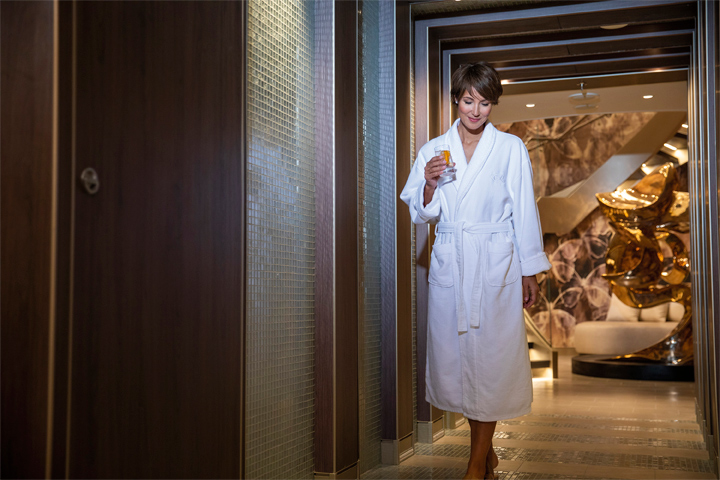
Full-Service Spa
- Full-Service Spa
- Spa Services/Massage
- Duty-Free Shops/Boutiques
- Infirmary/Medical Center
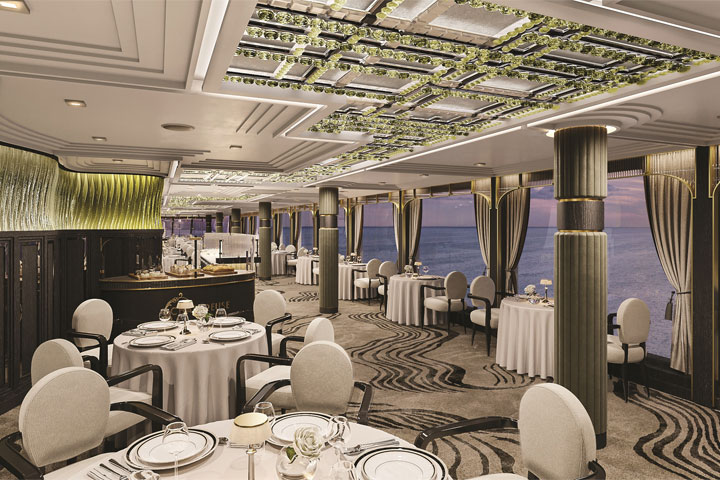
Chartreuse
Specialty Dining
Chartreuse: Featuring a classic French menu with a modern twist, Chartreuse evokes memories of a chic Parisian fine dining restaurant discovered during an evening stroll. Wherever you are seated in this regal restaurant, you will be treated to a succulent dinner while enjoying incredible ocean views. The restaurant ambiance is complemented by a menu that features dishes expertly prepared using both classic and modern techniques for a multiple course celebration of French gastronomy.
Compass Rose: Much thought was given to the design of Compass Rose, the flagship restaurant of Regent Seven Seas fleet. The dining room is outfitted with rich woods contrasted by light marble stones and mother of pearl shimmering brightly with an elegant color theme of light shades of blue, white, gold and silver. Compass Rose delights with a beautifully defined atmosphere and transitions from refreshing natural light during the day to a romantic ice blue lighting theme at night. This is the perfect setting for you to enjoy your breakfast, lunch and dinner, where the menu features an exceptional variety of Continental cuisine.
Pacific Rim: Celebrating the culinary traditions of Asia, Pacific Rim delights guests with the perfect balance of delicious flavors and Zen-like ambiance. The restaurant is located on Deck 5, and the interior glows with muted lighting that illuminates intricate architectural details. During dinner, guests are treated to incredible ocean views through windows designed in an abstract lotus shape, a universal Asian motif. To complement the stunning décor, Pacific Rim's chefs created a delectable menu of Pan-Asian creations with dishes such as grilled Korean barbecue lamb chops, wok-fried beans, eryngii mushroom and gochujang dressing. Pacific Rim is open for dinner each evening, reservations are required.
Prime 7: A true classic in every sense, Prime 7 sets a new standard in steakhouse fare with its contemporary interpretation of an American favorite. Handsomely decorated with supple leather wing-back chairs, burnished woods and rich earth-toned fabrics, Prime 7 exudes a distinct, intimate elegance. All the traditional starters are here, including Jumbo Lump Crab Cakes, Classic Steak Tartare, and Clam Chowder. Of course, beef is the undisputed star, and it is all USDA Prime and Dry-Aged at least 28 days to ensure the ultimate tenderness, juiciness and flavor. Prime New York Strip, Porterhouse Steak and succulent Filet Mignon only touch upon the selections. Mouthwatering alternatives include Alaskan King Crab Legs and Dover Sole. Prime 7 is open for dinner only and reservations are required.
Sette Mari at La Veranda: Each evening, La Veranda transforms into Sette Mari at La Veranda, a casual, intimate dining experience. Enjoy an extensive menu of authentic antipasti and Italian specialties served á la carte and paired with fine Italian wines — complimentary of course. Delectable dishes are prepared á la minute by talented chefs using only the freshest gourmet ingredients and served by attentive waiters. Sette Mari at La Veranda is open for dinner only.
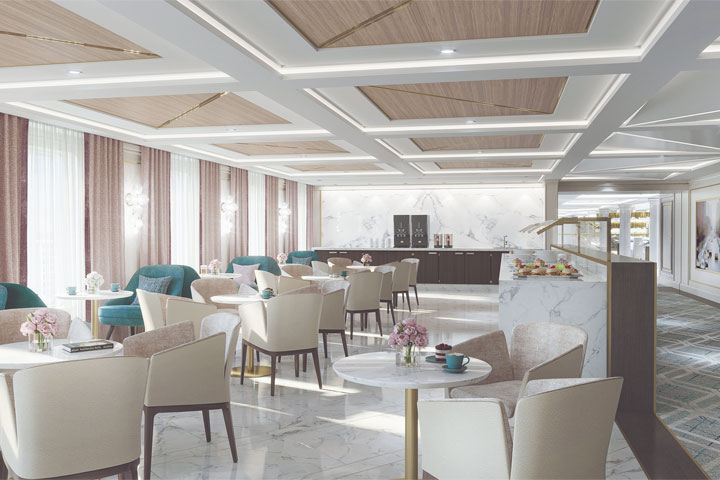
Coffee Connection
Casual Dining
Coffee Connection: Your informal destination to relax, meet fellow guests and enjoy coffee and snacks throughout the day. While snacking, international newspapers and news magazines are available for your perusal.
La Veranda Restaurant: Take in stunning ocean views while enjoying elegant breakfast and lunch buffets in the chic indoor dining room or al fresco on the shaded, open-air deck. Breakfasts include traditional favorites, as well as a made-to-order omelet station, a variety of fresh fruits and pastries, along with daily specials, like fluffy Belgian waffles with fresh blueberry compote. For lunch indulge in an array of choices from a bountiful salad bar, gourmet sandwiches, hot carving stations and delicious desserts.
Pool Grill: The Pool Grill is open-air, yet abundantly shaded for comfortable dining. Enjoy grilled-to-order burgers, grilled seafood, sandwiches, and fresh salads. Treat yourself to milkshakes and malts or an old-fashioned hand-dipped ice cream dessert sprinkled with all your favorite toppings.
Room Service: Complimentary 24-hour dining in the comfort of your stateroom.
Features a European king-size bed, a sitting area, a marble bathroom, a walk-in closet and a balcony. Concierge Level is available.
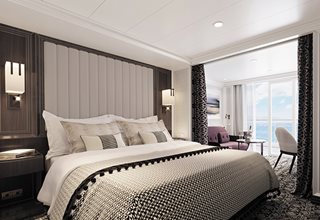
Category: G1
First, the view — soak in the entirety of your ocean-going adventure out on your private balcony, or get cozy in your floor-to-ceiling-windowed sitting area. Inside is perfectly designed for maximum elegance and comfort.
Suite size: 23.5 m²
Balcony size: 8.2 m²
Amenities:- Unlimited Wi-Fi Includes Two Logins, Two Devices, per Suite
- Valet Laundry Service
- Customizable In-Suite Mini Bar Replenished Daily with Your Preferences
- Welcome Bottle of Champagne and Fresh Fruit
- 24-hour In-Suite Dining
- Fresh Orchid Arrangement
- L'Occitane® Jasmin & Bergamot Bath Amenities
- Regent Plush Bathrobe and Slippers
- Interactive Flat-Screen Television and Direct-Dial Satellite Phone
- Vanity and Hair Dryer
- Shoe Shine Service

Category: G2
First, the view — soak in the entirety of your ocean-going adventure out on your private balcony, or get cozy in your floor-to-ceiling-windowed sitting area. Inside is perfectly designed for maximum elegance and comfort.
Suite size: 23.5 m²
Balcony size: 5.1-10.0 m²
Amenities:- Unlimited Wi-Fi Includes Two Logins, Two Devices, per Suite
- Valet Laundry Service
- Customizable In-Suite Mini Bar Replenished Daily with Your Preferences
- Welcome Bottle of Champagne and Fresh Fruit
- 24-hour In-Suite Dining
- Fresh Orchid Arrangement
- L'Occitane® Jasmin & Bergamot Bath Amenities
- Regent Plush Bathrobe and Slippers
- Interactive Flat-Screen Television and Direct-Dial Satellite Phone
- Vanity and Hair Dryer
- Shoe Shine Service

Category: H
A private balcony to sip the beverage of your choice, a sitting area with a table for in-suite breakfasts, lavish bath products, a flat-screen TV... this suite has all you need to feel spoiled on an unforgettable voyage.
Suite size: 20.4 m²
Balcony size: 8.2 m²
Amenities:- Unlimited Wi-Fi Includes Two Logins, Two Devices, per Suite
- Valet Laundry Service
- Customizable In-Suite Mini Bar Replenished Daily with Your Preferences
- Welcome Bottle of Champagne and Fresh Fruit
- 24-hour In-Suite Dining
- Fresh Orchid Arrangement
- L'Occitane® Jasmin & Bergamot Bath Amenities
- Regent Plush Bathrobe and Slippers
- Interactive Flat-Screen Television and Direct-Dial Satellite Phone
- Vanity and Hair Dryer
- Shoe Shine Service
Spacious suites feature an in-suite iPad, daily canapés and upgraded bathroom amenities.
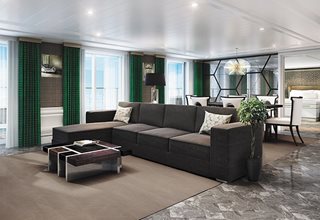
Category: GS
Experience the joy of sailing the world with an exquisitely designed space like this suite to call home throughout your voyage. Indulge in a sumptuous living room, two full baths, lavish bath products, and a private balcony.
The suite pictured may differ from the suite booked, as layouts and designs vary by ship, deck, and suite location.
Suite size: 79.3-94.1 m²
Balcony size: 25.7-85.1 m²
Amenities:- 1-Night Pre-Cruise Hotel Package Including:
- Ground Transfers
- Breakfast
- Porterage
- Unlimited Wi-Fi Includes up to Four Logins, Four Devices, per Suite
- Valet Laundry Service
- 24-hour In-Suite Dining
- Fresh Orchid Arrangement
- L'Occitane® Jasmin & Bergamot Bath Amenities
- Regent Plush Bathrobe and Slippers
- Interactive Flat-Screen Television and Direct-Dial Satellite Phone
- Priority Access to Online Shore Excursion Reservations
- Priority Access to Online Dining Reservations
- Binoculars
- illy® Espresso Maker
- Cashmere Blankets
- Regent Special Gift
- Vanity and Hair Dryer
- Shoe Shine Service
- Additional Discounts:
- 10% Discount on Ultra Premium Wine and Liquor
- 5% Savings on Pre- or Post-Cruise Hotel or Land Programs
- 5% Savings on Regent Choice Shore Excursions
- VIP Status Including Dinner with a Senior Officer
- Guaranteed Reservation Each Night in Specialty Restaurant of Your Choice
- Welcome Letter from the President and General Manager
- Personal Butler for an Elevated In-Suite Experience
- In-Suite Dining Menu Including Specialty Restaurant Selections During Dining Hours
- Priority Boarding on Embarkation Day with Suite Access at Noon
- Welcome Bottle of Premium Champagne
- Personalized In-Suite Full-Liquor Bar Set-Up
- A Sumptuous In-Suite Caviar Service Once During Cruises
- Complimentary In-Suite Cocktail Party for 8
- Complimentary 25-Minute Personal Fitness Session at the Serene Spa & Wellness™ Fitness Center
- Delivery of up to 3 Daily Newspapers and World Atlas
- Daily Canapés
- Tea Forté Set-Up
- Luxe Fruit Arrangement with Chocolate Leonidas
- Luxurious Designer Bath Amenities & Men's Unscented Shaving Kit
- Guerlain Box with Fragrance & Spongellé Buffer
- Dyson Hair Dryer
- Selection of Fig and Tea Leaves Bath Salts
- Guerlain Bath Amenities & Men's Unscented Shaving Kit
- Bath Scale Setup
- Bose® SoundLink Mini II Bluetooth Speaker
- Selection of Bed Pillow Styles
- Complimentary Garment Pressing on First Night
- Personalized Stationery upon request
- Elegant Weather Clock
- Excursion Bag
- 1-Night Pre-Cruise Hotel Package Including:
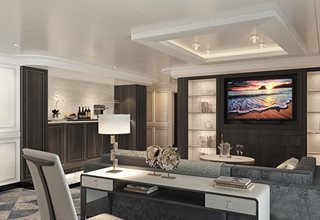
Category: SG
A rich color palette and the finest fabrics create sophisticated comfort and a true urban chic. Plenty of space, including a large living room and a wrap-around private balcony, makes entertaining a breeze.
Suite size: 98.9-103.5 m²
Balcony size: 77.2-92.4 m²
Amenities:- 1-Night Pre-Cruise Hotel Package Including:
- Ground Transfers
- Breakfast
- Porterage
- Unlimited Wi-Fi and Streaming Package for up to Four Devices
- Valet Laundry Service
- 24-hour In-Suite Dining
- Fresh Orchid Arrangement
- L'Occitane® Jasmin & Bergamot Bath Amenities
- Regent Plush Bathrobe and Slippers
- Interactive Flat-Screen Television and Direct-Dial Satellite Phone
- Priority Access to Online Shore Excursion Reservations
- Priority Access to Online Dining Reservations
- Binoculars
- illy® Espresso Maker
- Cashmere Blankets
- Regent Special Gift
- Vanity and Hair Dryer
- Shoe Shine Service
- Additional Discounts:
- 10% Discount on Ultra Premium Wine and Liquor
- 5% Savings on Pre- or Post-Cruise Hotel or Land Programs
- 5% Savings on Regent Choice Shore Excursions
- VIP Status Including Dinner with a Senior Officer
- Guaranteed Reservation Each Night in Specialty Restaurant of Your Choice
- Welcome Letter from the President and General Manager
- Personal Butler for an Elevated In-Suite Experience
- In-Suite Dining Menu Including Specialty Restaurant Selections During Dining Hours
- Priority Boarding on Embarkation Day with Suite Access at Noon
- Welcome Bottle of Premium Champagne
- Personalized In-Suite Full-Liquor Bar Set-Up
- A Sumptuous In-Suite Caviar Service Once During Cruises
- Complimentary In-Suite Cocktail Party for 8
- Complimentary 25-Minute Personal Fitness Session at the Serene Spa & Wellness™ Fitness Center
- Delivery of up to 3 Daily Newspapers and World Atlas
- Daily Canapés
- Tea Forté Set-Up
- Luxe Fruit Arrangement with Chocolate Leonidas
- Luxurious Designer Bath Amenities & Men's Unscented Shaving Kit
- Guerlain Box with Fragrance & Spongellé Buffer
- Dyson Hair Dryer
- Selection of Fig and Tea Leaves Bath Salts
- Guerlain Bath Amenities & Men's Unscented Shaving Kit
- Bath Scale Setup
- Bose® SoundLink Mini II Bluetooth Speaker
- Selection of Bed Pillow Styles
- Complimentary Garment Pressing on First Night
- Personalized Stationery upon request
- Elegant Weather Clock
- Excursion Bag
- 1-Night Pre-Cruise Hotel Package Including:
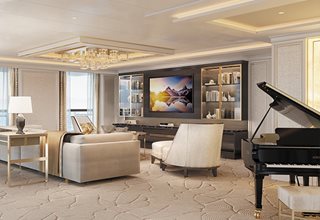
Category: RS
A one-of-a-kind achievement in lavish accommodations, this unparalleled suite boasts an in-suite spa retreat, private balcony with a Treesse Mini Pool, two magnificent bedrooms and more. Simply astonishing luxury.
Suite size: 352.7 m²
Balcony size: 120 m²
Amenities:- 1-Night Pre-Cruise Hotel Package Including:
- Ground Transfers
- Breakfast
- Porterage
- Unlimited Wi-Fi and Streaming Package for up to Four Devices
- Valet Laundry Service
- 24-hour In-Suite Dining
- Fresh Orchid Arrangement
- L'Occitane® Jasmin & Bergamot Bath Amenities
- Regent Plush Bathrobe and Slippers
- Interactive Flat-Screen Television and Direct-Dial Satellite Phone
- Priority Access to Online Shore Excursion Reservations
- Priority Access to Online Dining Reservations
- Binoculars
- illy® Espresso Maker
- Cashmere Blankets
- Regent Special Gift
- Vanity and Hair Dryer
- Shoe Shine Service
- Additional Discounts:
- 10% Discount on Ultra Premium Wine and Liquor
- 5% Savings on Pre- or Post-Cruise Hotel or Land Programs
- 5% Savings on Regent Choice Shore Excursions
- Personal Car and Guide to Explore Ashore
- Daily Serene Spa & Wellness™ Services with Priority Reservations
- Access to The Study, a Private Dining Room for up to 12 Guests
- Unlimited Dry Cleaning
- VIP Status Including Dinner with a Senior Officer
- Guaranteed Reservation Each Night in Specialty Restaurant of Your Choice
- Welcome Letter from the President and General Manager
- Personal Butler for an Elevated In-Suite Experience
- In-Suite Dining Menu Including Specialty Restaurant Selections During Dining Hours
- Priority Boarding on Embarkation Day with Suite Access at Noon
- Welcome Bottle of Dom Pérignon Champagne
- Rémy Martin Louis XIII Cognac 50ml
- Personalized In-Suite Full-Liquor Bar Set-Up
- A Sumptuous In-Suite Caviar Service Once During Cruises
- Complimentary In-Suite Cocktail Party for 8
- Complimentary 25-Minute Personal Fitness Session at the Serene Spa & Wellness™ Fitness Center
- Delivery of up to 3 Daily Newspapers and World Atlas
- Daily Canapés
- Tea Forté Set-Up
- Luxe Fruit Arrangement with Chocolate Leonidas
- Choice of Luxurious Designer Bath Amenities
- Spa Accessories and Spongology Collection
- Guerlain Box with Fragrance & Spongellé Buffer
- Dyson Hair Dryer
- Selection of Fig and Tea Leaves Bath Salts
- Guerlain Bath Amenities & Men's Unscented Shaving Kit
- Bath Scale Setup
- Wallet Make Up Brush Set / Hairbrush and Combo Set
- Bose® SoundLink Mini II Bluetooth Speaker
- Selection of Bed Pillow Styles
- Linen Menu
- Complimentary Garment Pressing on First Night
- Personalized Stationery upon request
- Elegant Weather Clock
- Excursion Bag
- 1-Night Pre-Cruise Hotel Package Including:
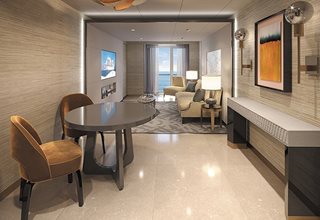
Category: GN
A glamorous home away from home with a private balcony that's among the largest at sea. Luxuriate in its spacious living room and sitting area, and impress guests with a full-liquor bar and in-suite caviar service.
Suite size: 60.9 m²
Balcony size: 15.4-24.4 m²
Amenities:- 1-Night Pre-Cruise Hotel Package Including:
- Ground Transfers
- Breakfast
- Porterage
- Unlimited Wi-Fi Includes up to Four Logins, Four Devices, per Suite
- Valet Laundry Service
- 24-hour In-Suite Dining
- Fresh Orchid Arrangement
- L'Occitane® Jasmin & Bergamot Bath Amenities
- Regent Plush Bathrobe and Slippers
- Interactive Flat-Screen Television and Direct-Dial Satellite Phone
- Priority Access to Online Shore Excursion Reservations
- Priority Access to Online Dining Reservations
- Binoculars
- illy® Espresso Maker
- Cashmere Blankets
- Regent Special Gift
- Vanity and Hair Dryer
- Shoe Shine Service
- Additional Discounts:
- 10% Discount on Ultra Premium Wine and Liquor
- 5% Savings on Pre- or Post-Cruise Hotel or Land Programs
- 5% Savings on Regent Choice Shore Excursions
- Welcome Letter from the President and General Manager
- Personal Butler for an Elevated In-Suite Experience
- In-Suite Dining from Compass Rose
- Priority Boarding on Embarkation Day with Suite Access at 1 pm
- Welcome Bottle of Premium Champagne
- Personalized In-Suite Full-Liquor Bar Set-Up
- A Sumptuous In-Suite Caviar Service Once During Cruises
- Delivery of up to 3 Daily Newspapers and World Atlas
- Daily Canapés
- Luxe Fruit Arrangement
- Luxurious Designer Bath Amenities & Men's Unscented Shaving Kit
- Selection of Fig and Tea Leaves Bath Salts
- Guerlain Bath Amenities & Men's Unscented Shaving Kit
- Bath Scale Setup
- Bose® SoundLink Mini II Bluetooth Speaker
- Selection of Bed Pillow Styles
- Complimentary Garment Pressing on First Night
- Personalized Stationery upon request
- Elegant Weather Clock
- 1-Night Pre-Cruise Hotel Package Including:
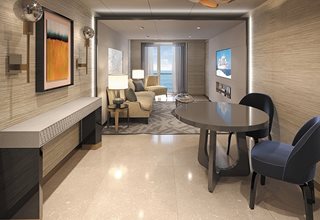
Category: SS
With glorious vistas in every direction, this suite is designed to complement the soothing nature of the world outside. Your private balcony will beckon from your stylish sitting area, as will the marble accents of your baths.
Suite size: 53.6 m²
Balcony size: 22 m²
Amenities:- 1-Night Pre-Cruise Hotel Package Including:
- Ground Transfers
- Breakfast
- Porterage
- Unlimited Wi-Fi Includes up to Four Logins, Four Devices, per Suite
- Valet Laundry Service
- Customizable In-Suite Mini Bar Replenished Daily with Your Preferences
- 24-hour In-Suite Dining
- Fresh Orchid Arrangement
- Luxurious Bath Amenities and Men's Unscented Shaving Kit
- Regent Plush Bathrobe and Slippers
- Interactive Flat-Screen Television and Direct-Dial Satellite Phone
- Priority Access to Online Shore Excursion Reservations
- Priority Access to Online Dining Reservations
- Binoculars
- illy® Espresso Maker
- Cashmere Blankets
- Regent Special Gift
- Vanity and Hair Dryer
- Shoe Shine Service
- Additional Discounts:
- 10% Discount on Ultra Premium Wine and Liquor
- 5% Savings on Pre- or Post-Cruise Hotel or Land Programs
- 5% Savings on Regent Choice Shore Excursions
- Personal Butler for an Elevated In-Suite Experience
- In-Suite Dining from Compass Rose
- Priority Boarding on Embarkation Day with Suite Access at 1 pm
- Daily Canapés
- Luxe Fruit Arrangement
- Luxurious Bath Amenities and Men's Unscented Shaving Kit
- Selection of Fig and Tea Leaves Bath Salts
- Bose® SoundLink Mini II Bluetooth Speaker
- Selection of Bed Pillow Styles
- Complimentary Garment Pressing on First Night
- Personalized Stationery upon request
- Elegant Weather Clock
- 1-Night Pre-Cruise Hotel Package Including:
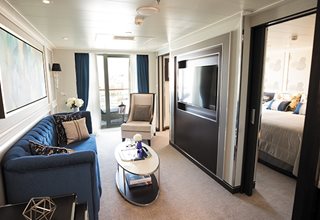
Category: A
Designed to maximize your space and comfort — highlighted by a beautifully furnished sitting area and private balcony — you'll relish time spent in this luxurious suite as you prepare for your next onshore adventure.
Suite size: 41.8 m²
Balcony size: 10.3-16.4 m²
Amenities:- 1-Night Pre-Cruise Hotel Package Including:
- Ground Transfers
- Breakfast
- Porterage
- Unlimited Wi-Fi Includes up to Four Logins, Four Devices, per Suite
- Valet Laundry Service
- Customizable In-Suite Mini Bar Replenished Daily with Your Preferences
- Welcome Bottle of Champagne and Fresh Fruit
- 24-hour In-Suite Dining
- Fresh Orchid Arrangement
- L'Occitane® Jasmin & Bergamot Bath Amenities
- Regent Plush Bathrobe and Slippers
- Interactive Flat-Screen Television and Direct-Dial Satellite Phone
- Priority Access to Online Shore Excursion Reservations
- Priority Access to Online Dining Reservations
- Binoculars
- illy® Espresso Maker
- Cashmere Blankets
- Regent Special Gift
- Vanity and Hair Dryer
- Shoe Shine Service
- Additional Discounts:
- 10% Discount on Ultra Premium Wine and Liquor
- 5% Savings on Pre- or Post-Cruise Hotel or Land Programs
- 5% Savings on Regent Choice Shore Excursions
- Personal Butler for an Elevated In-Suite Experience
- In-Suite Dining from Compass Rose
- Daily Canapés
- Luxurious Designer Bath Amenities & Men's Unscented Shaving Kit
- Guerlain Bath Amenities & Men's Unscented Shaving Kit
- Bose® SoundLink Mini II Bluetooth Speaker
- Selection of Bed Pillow Styles
- Complimentary Garment Pressing on First Night
- Personalized Stationery upon request
- 1-Night Pre-Cruise Hotel Package Including:

Category: B
Designed to maximize your space and comfort — highlighted by a beautifully furnished sitting area and private balcony — you'll relish time spent in this luxurious suite as you prepare for your next onshore adventure.
Suite size: 41.8 m²
Balcony size: 10.3-16.4 m²
Amenities:- 1-Night Pre-Cruise Hotel Package Including:
- Ground Transfers
- Breakfast
- Porterage
- Unlimited Wi-Fi Includes up to Four Logins, Four Devices, per Suite
- Valet Laundry Service
- Customizable In-Suite Mini Bar Replenished Daily with Your Preferences
- Welcome Bottle of Champagne and Fresh Fruit
- 24-hour In-Suite Dining
- Fresh Orchid Arrangement
- L'Occitane® Jasmin & Bergamot Bath Amenities
- Regent Plush Bathrobe and Slippers
- Interactive Flat-Screen Television and Direct-Dial Satellite Phone
- Priority Access to Online Shore Excursion Reservations
- Priority Access to Online Dining Reservations
- Binoculars
- illy® Espresso Maker
- Cashmere Blankets
- Regent Special Gift
- Vanity and Hair Dryer
- Shoe Shine Service
- Additional Discounts:
- 10% Discount on Ultra Premium Wine and Liquor
- 5% Savings on Pre- or Post-Cruise Hotel or Land Programs
- 5% Savings on Regent Choice Shore Excursions
- Personal Butler for an Elevated In-Suite Experience
- In-Suite Dining from Compass Rose
- Daily Canapés
- Luxurious Designer Bath Amenities & Men's Unscented Shaving Kit
- Guerlain Bath Amenities & Men's Unscented Shaving Kit
- Bose® SoundLink Mini II Bluetooth Speaker
- Selection of Bed Pillow Styles
- Complimentary Garment Pressing on First Night
- Personalized Stationery upon request
- 1-Night Pre-Cruise Hotel Package Including:

Category: C
Designed to maximize your space and comfort — highlighted by a beautifully furnished sitting area and private balcony — you'll relish time spent in this luxurious suite as you prepare for your next onshore adventure.
Suite size: 41.8 m²
Balcony size: 10.3-18.0 m²
Amenities:- 1-Night Pre-Cruise Hotel Package Including:
- Ground Transfers
- Breakfast
- Porterage
- Unlimited Wi-Fi Includes up to Four Logins, Four Devices, per Suite
- Valet Laundry Service
- Customizable In-Suite Mini Bar Replenished Daily with Your Preferences
- Welcome Bottle of Champagne and Fresh Fruit
- 24-hour In-Suite Dining
- Fresh Orchid Arrangement
- L'Occitane® Jasmin & Bergamot Bath Amenities
- Regent Plush Bathrobe and Slippers
- Interactive Flat-Screen Television and Direct-Dial Satellite Phone
- Priority Access to Online Shore Excursion Reservations
- Priority Access to Online Dining Reservations
- Binoculars
- illy® Espresso Maker
- Cashmere Blankets
- Regent Special Gift
- Vanity and Hair Dryer
- Shoe Shine Service
- Additional Discounts:
- 10% Discount on Ultra Premium Wine and Liquor
- 5% Savings on Pre- or Post-Cruise Hotel or Land Programs
- 5% Savings on Regent Choice Shore Excursions
- Personal Butler for an Elevated In-Suite Experience
- In-Suite Dining from Compass Rose
- Daily Canapés
- Luxurious Designer Bath Amenities & Men's Unscented Shaving Kit
- Guerlain Bath Amenities & Men's Unscented Shaving Kit
- Bose® SoundLink Mini II Bluetooth Speaker
- Selection of Bed Pillow Styles
- Complimentary Garment Pressing on First Night
- Personalized Stationery upon request
- 1-Night Pre-Cruise Hotel Package Including:
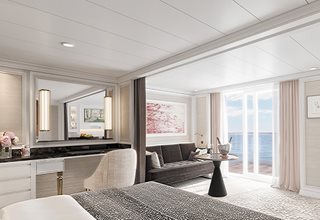
Category: D
Step out onto your private balcony with a freshly made cup of coffee and take in the grandeur of ocean travel. This suite is packed with stylish comfort and includes a king-sized bed with a spectacular horizon view.
Suite size: 30.8 m²
Balcony size: 7.7-12.3 m²
Amenities:- 1-Night Pre-Cruise Hotel Package Including:
- Ground Transfers
- Breakfast
- Porterage
- Unlimited Wi-Fi Includes up to Four Logins, Four Devices, per Suite
- Valet Laundry Service
- Customizable In-Suite Mini Bar Replenished Daily with Your Preferences
- Welcome Bottle of Champagne and Fresh Fruit
- 24-hour In-Suite Dining
- Fresh Orchid Arrangement
- L'Occitane® Jasmin & Bergamot Bath Amenities
- Regent Plush Bathrobe and Slippers
- Interactive Flat-Screen Television and Direct-Dial Satellite Phone
- Priority Access to Online Shore Excursion Reservations
- Priority Access to Online Dining Reservations
- Binoculars
- illy® Espresso Maker
- Cashmere Blankets
- Regent Special Gift
- Vanity and Hair Dryer
- Shoe Shine Service
- Additional Discounts:
- 10% Discount on Ultra Premium Wine and Liquor
- 5% Savings on Pre- or Post-Cruise Hotel or Land Programs
- 5% Savings on Regent Choice Shore Excursions
- 1-Night Pre-Cruise Hotel Package Including:

Category: E
Step out onto your private balcony with a freshly made cup of coffee and take in the grandeur of ocean travel. This suite is packed with stylish comfort and includes a king-sized bed with a spectacular horizon view.
Suite size: 30.8 m²
Balcony size: 10.7-12.3 m²
Amenities:- 1-Night Pre-Cruise Hotel Package Including:
- Ground Transfers
- Breakfast
- Porterage
- Unlimited Wi-Fi Includes up to Four Logins, Four Devices, per Suite
- Valet Laundry Service
- Customizable In-Suite Mini Bar Replenished Daily with Your Preferences
- Welcome Bottle of Champagne and Fresh Fruit
- 24-hour In-Suite Dining
- Fresh Orchid Arrangement
- L'Occitane® Jasmin & Bergamot Bath Amenities
- Regent Plush Bathrobe and Slippers
- Interactive Flat-Screen Television and Direct-Dial Satellite Phone
- Priority Access to Online Shore Excursion Reservations
- Priority Access to Online Dining Reservations
- Binoculars
- illy® Espresso Maker
- Cashmere Blankets
- Regent Special Gift
- Vanity and Hair Dryer
- Shoe Shine Service
- Additional Discounts:
- 10% Discount on Ultra Premium Wine and Liquor
- 5% Savings on Pre- or Post-Cruise Hotel or Land Programs
- 5% Savings on Regent Choice Shore Excursions
- 1-Night Pre-Cruise Hotel Package Including:

Category: F1
Sometimes, a bit of extra space goes a long way. With a stylish living area that includes a sitting area, walk-in closet and dual sinks in the bathroom, you'll have more room to unwind after your daily adventures.
Suite size: 30.8 m²
Balcony size: 7.7-12.3 m²
Amenities:- Unlimited Wi-Fi Includes Two Logins, Two Devices, per Suite
- Valet Laundry Service
- Customizable In-Suite Mini Bar Replenished Daily with Your Preferences
- Welcome Bottle of Champagne and Fresh Fruit
- 24-hour In-Suite Dining
- Fresh Orchid Arrangement
- L'Occitane® Jasmin & Bergamot Bath Amenities
- Regent Plush Bathrobe and Slippers
- Interactive Flat-Screen Television and Direct-Dial Satellite Phone
- Vanity and Hair Dryer
- Shoe Shine Service

Category: F2
A bit of extra space always goes a long way. With a stylish living area that includes a sitting area, walk-in closet and dual sinks in the bathroom, you'll have more room to unwind after your daily adventures.
Suite size: 30.8 m²
Balcony size: 7.7-10.7 m²
Amenities:- Unlimited Wi-Fi Includes Two Logins, Two Devices, per Suite
- Valet Laundry Service
- Customizable In-Suite Mini Bar Replenished Daily with Your Preferences
- Welcome Bottle of Champagne and Fresh Fruit
- 24-hour In-Suite Dining
- Fresh Orchid Arrangement
- L'Occitane® Jasmin & Bergamot Bath Amenities
- Regent Plush Bathrobe and Slippers
- Interactive Flat-Screen Television and Direct-Dial Satellite Phone
- Vanity and Hair Dryer
- Shoe Shine Service
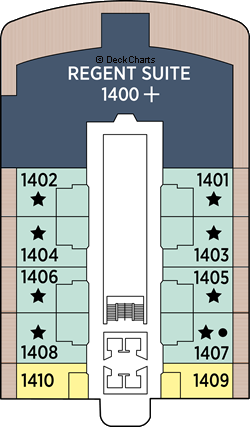
| Symbol | Description |
|---|---|
 | 2-bedroom suites accommodate up to six guests |
 | Convertible sofa bed |
 | Wheelchair accessible suites 822, 823, and 916 have a shower instead of bathtub |
 | Connecting suites |
 | Bathroom features a glass-enclosed shower instead of a bath in categories A, B, C, G1, G2, and H |
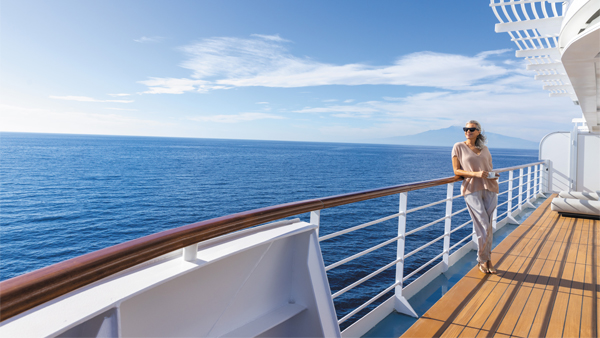
- Ship Name: Seven Seas Grandeur
- Year Built: 2023
- Year Entered Present Fleet: 2023
- Ship Class: Oceanliner
- Maximum Capacity: 750
- Number of Passenger Decks: 10
- Number of Crew: 542
- Officers' Nationality: European
- Tonnage (GRT): 55,498
- Capacity Based on Double Occupancy: 750
- Country of Registry: Marshall Islands
- Total Staterooms: 375
- Suites with Balcony: 375
- Crew/Hotel Staff Nationality: European/International
Costco Member Reviews

Available Dates & Prices
Terms & Conditions
*Price shown is per person based on double occupancy, is valid for select stateroom categories only and does include government taxes/fees and gratuities. Click on the Terms & Conditions link below for details
**Select complimentary shore excursions are for full-fare guests only, capacity controlled and subject to availability. Shore excursion reservations are accepted on a first-come, first-served basis. Please note, available excursions vary by sailing date and day of the week. Government fees and taxes are included. Requested excursions may not be available at time of booking. Supplement will apply on Regent Choice excursions and excludes Private Arrangements and all Adventures Ashore programs. Restrictions apply and penalties apply 36 hours prior to shore excursion start date.
††All shipboard credit is in U.S. dollars, is per stateroom based on double occupancy, has no cash value, is nontransferable and not redeemable for cash.
†One Digital Costco Shop Card per room/stateroom, per stay. The exact amount of the Digital Costco Shop Card will be calculated during the booking process. The Digital Costco Shop Card promotion is nontransferable and may not be combined with any other promotion. A Digital Costco Shop Card will arrive by email approximately 10 days after the start of your cruise. Click on the Terms & Conditions link below for additional information.
Ship's registry: The Marshall Islands
Digital Costco Shop Card
Book this vacation or cruise with Costco Travel and receive a Digital Costco Shop Card. The Digital Costco Shop Card is a convenient payment option in our warehouses and on Costco.com.
















